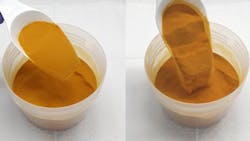Researchers form Flinders University have expanded testing of a sustainable extraction material capable of absorbing almost mercury in polluted water — the material itself made entirely from low-cost waste from petroleum, citrus, and agricultural production.
In fact, the tests showed almost total absorption of mercury within minutes in trial conditions, said senior author Justin Chalker and fellow scientists, who all worked on the new journal article published by the Royal Society of Chemistry.
“It is clear from the study that this mercury-binding material, invented at Flinders University, is ultra-fast in its ability to remove mercury from water,” said Chalker in a press release. “In some cases, more than 99 percent of the mercury is captured in just a few minutes,”
Chalker Lab co-author Max Worthington said testing was done on a new material created by coating silica with sulfur and limonene — a novel chemical combination already shown to effectively absorb waste mercury.
“This silica covered with an ultra-thin coating of poly(S-r-limonene), using sulfur left over in petroleum production and orange oil from orange peels discarded by the citrus industry, was extensively tested in various pH and salt concentrations,” Worthington said. “Not only is this new mercury sorbent able to rapidly bind to mercury in water, but it is also selective in taking up mercury —not other metal contaminants such as iron, copper, cadmium, lead, zinc and aluminium.”
Importantly, this means that only mercury will bind to the orange-sulfur sorbent, which helps with safety after capturing the inorganic mercury, added co-author Max Mann.
“The particles contained in just 27g of this free-flowing orange powder has an approximate surface area of a soccer field, and it can be quickly produced in large enough volumes to suit contamination levels,” said Mann.
“This is an exciting new development in producing renewable and accessible solutions to major environmental issues facing the world today,” says applied mathematician Tony Miller, another co-author on the publication in Physical Chemistry, Chemistry Physics.
The article, “Modelling mercury sorption of a polysulfide coating made from sulfur and limonene,” (2022) by Max JH Worthington, et al., has been published in Physical Chemistry, Chemistry Physics. DOI: 10.1039/D2CP01903E



